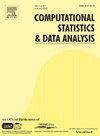回归模型中平滑项的局部化差异的同步置信度有界真发现比例视角
IF 1.6
3区 数学
Q3 COMPUTER SCIENCE, INTERDISCIPLINARY APPLICATIONS
引用次数: 0
摘要
演示了一种方法,用于定位两个样条项,或平滑,使用真实发现比例(TDP)为基础的解释不同。这个过程产生一个关于某些区域的比例的陈述,其中两个平滑之间存在真正的差异。该方法避免了对数据进行细分和对截断的样条项进行假设检验等特别的方法。TDP估计值同时具有1-α置信限,这意味着一个地区的TDP估计值是该地区实际差异或真实发现比例的下界,无论估计值的数量如何,都具有高置信度。该程序基于使用Simes本地测试的封闭测试。该局部检验要求该方法基础的广义Wishart类型的多变量χ2检验统计量是依赖于子集的正回归(PRDS),该结果有证据表明该条件成立。对于采用REML或GCV选择的整定参数的广义加性模型,证明了该过程的一致性,并通过仿真和步态分析证明了置信度有界TDP的实现。本文章由计算机程序翻译,如有差异,请以英文原文为准。
A simultaneous confidence-bounded true discovery proportion perspective on localizing differences in smooth terms in regression models
A method is demonstrated for localizing where two spline terms, or smooths, differ using a true discovery proportion (TDP)-based interpretation. The procedure yields a statement on the proportion of some region where true differences exist between two smooths. The methodology avoids ad hoc approaches to making such statements, like subsetting the data and performing hypothesis tests on the truncated spline terms. TDP estimates are 1-α confidence-bounded simultaneously, which means that a region's TDP estimate is a lower bound on the proportion of actual differences, or true discoveries, in that region, with high confidence regardless of the number of estimates made. The procedure is based on closed-testing using Simes local test. This local test requires that the multivariate test statistics of generalized Wishart type underlying the method be positive regression dependent on subsets (PRDS), a result for which evidence is presented suggesting that the condition holds. Consistency of the procedure is demonstrated for generalized additive models with the tuning parameter chosen by REML or GCV, and the achievement of confidence-bounded TDP is shown in simulation as is an analysis of walking gait.
求助全文
通过发布文献求助,成功后即可免费获取论文全文。
去求助
来源期刊

Computational Statistics & Data Analysis
数学-计算机:跨学科应用
CiteScore
3.70
自引率
5.60%
发文量
167
审稿时长
60 days
期刊介绍:
Computational Statistics and Data Analysis (CSDA), an Official Publication of the network Computational and Methodological Statistics (CMStatistics) and of the International Association for Statistical Computing (IASC), is an international journal dedicated to the dissemination of methodological research and applications in the areas of computational statistics and data analysis. The journal consists of four refereed sections which are divided into the following subject areas:
I) Computational Statistics - Manuscripts dealing with: 1) the explicit impact of computers on statistical methodology (e.g., Bayesian computing, bioinformatics,computer graphics, computer intensive inferential methods, data exploration, data mining, expert systems, heuristics, knowledge based systems, machine learning, neural networks, numerical and optimization methods, parallel computing, statistical databases, statistical systems), and 2) the development, evaluation and validation of statistical software and algorithms. Software and algorithms can be submitted with manuscripts and will be stored together with the online article.
II) Statistical Methodology for Data Analysis - Manuscripts dealing with novel and original data analytical strategies and methodologies applied in biostatistics (design and analytic methods for clinical trials, epidemiological studies, statistical genetics, or genetic/environmental interactions), chemometrics, classification, data exploration, density estimation, design of experiments, environmetrics, education, image analysis, marketing, model free data exploration, pattern recognition, psychometrics, statistical physics, image processing, robust procedures.
[...]
III) Special Applications - [...]
IV) Annals of Statistical Data Science [...]
 求助内容:
求助内容: 应助结果提醒方式:
应助结果提醒方式:


